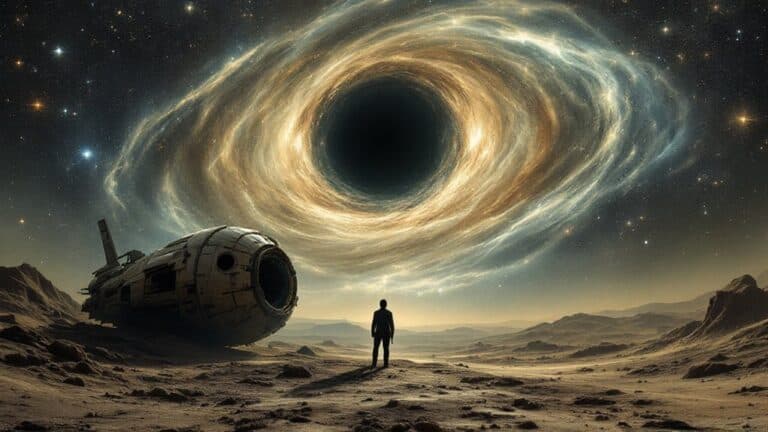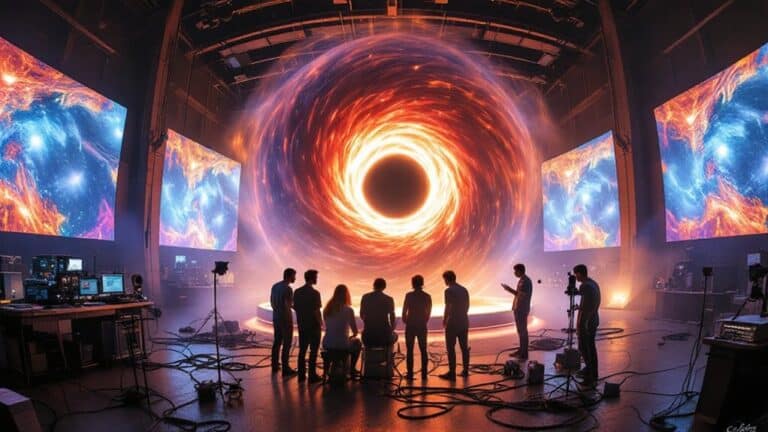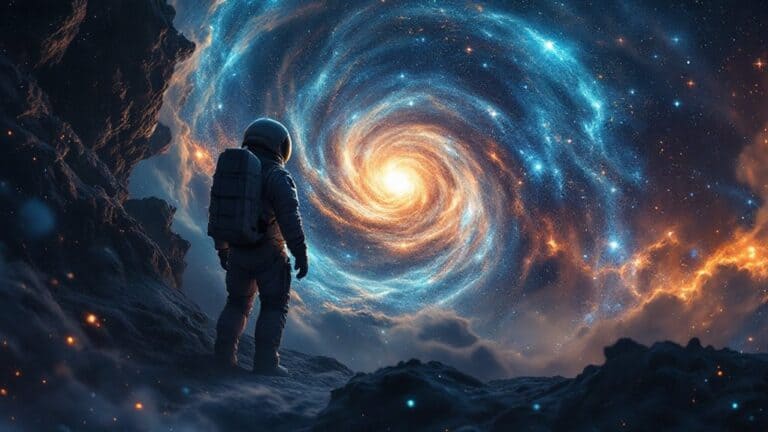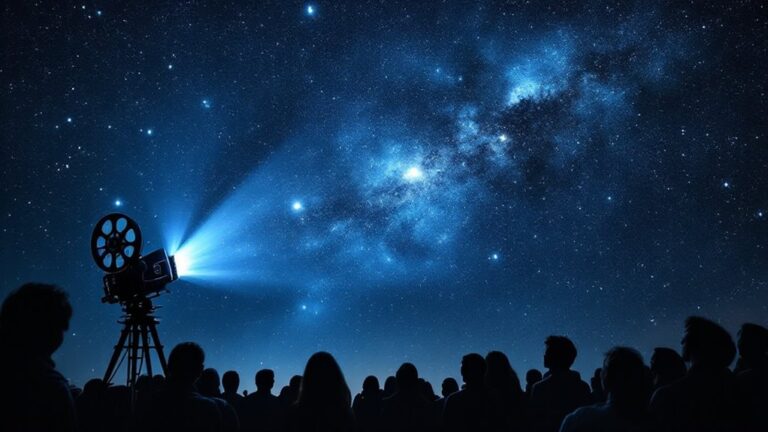Philosophical Themes in Interstellar’s Narrative
In “Interstellar,” you’re invited to grapple with profound philosophical themes that illuminate human existence and identity. The narrative explores the essence of love as a powerful survival tool, showcasing emotional bonds in the face of time dilation and isolation. You’ll encounter ethical dilemmas, as characters navigate the complex choices between personal sacrifice and collective survival, highlighting the tension between individual desires and humanity’s fate. Additionally, the interplay of science and philosophy invites reflections on time, consciousness, and interconnectedness. As you consider these elements, anticipate further insights that will deepen your understanding of the film’s rich tapestry.
Table of Contents
Key Takeaways
- The film explores existential questions regarding identity and humanity’s purpose, emphasizing the struggle for survival in a cosmic context.
- Emotional bonds and love are portrayed as essential survival mechanisms, transcending dimensions and influencing critical decision-making.
- Ethical dilemmas arise around prioritizing collective survival versus personal sacrifice, highlighting the moral complexities of humanity’s existence.
- Time dilation serves as a metaphor for life’s fragility, illustrating the emotional toll of aging loved ones while remaining unchanged.
- Interconnectedness across space underscores the significance of technology in fostering communication and connection, even amidst isolation and time discrepancies.
Human Existence and Place
As you explore “Interstellar,” you’ll find that the film intricately weaves the theme of human existence and place into its narrative fabric. It raises profound existential questions about our identity and purpose in the universe.
Through the characters of Cooper and Murph, you witness the powerful connection that transcends physical boundaries, illustrating that love and hope are essential facets of human identity. The film’s portrayal of love as a binding force emphasizes its significance in our relationships. Additionally, the film’s exploration of humanity’s struggle for survival highlights the urgency of our quest for a new home in the cosmos.
The film balances our earthly roots with the aspiration for something greater, encouraging you to reflect on the duality of being grounded yet yearning for transcendence.
As humanity grapples with its destiny amidst cosmic challenges, “Interstellar” invites you to contemplate what it means to be human, suggesting that our essence lies in our capacity for virtue and the pursuit of knowledge.
Time and Space Perception

In “Interstellar,” you witness the profound effects of time dilation, where just hours on Miller’s planet equate to decades on Earth, forcing you to confront the unsettling reality of how gravity shapes time. This distortion not only alters the crew’s perception of their own lives but also emphasizes the emotional weight of their sacrifices as they grapple with the irreversible consequences of their choices. As you explore these themes, you’ll find that the film beautifully intertwines the scientific principles of time and gravity with the deeply human experience of love and loss, leaving you to ponder what it truly means to exist in a universe governed by such complex laws. The extreme time dilation experienced by the crew serves as a poignant reminder of the vast differences in perception and experience dictated by the universe’s laws. Furthermore, the characters’ experiences highlight the theme of isolation and loneliness, as they cope with the emotional toll of being separated from their loved ones for extended periods.
Time Dilation Effects
While many people perceive time as a constant flow, the reality of time dilation reveals that this perception can drastically change based on speed and gravity.
In your journey through cosmic travel, you might experience relativistic effects that distort time perception, making mere hours translate to years on Earth. At near-light speeds, the astronaut’s experience showcases the concept of time dilation, where time passes more slowly for them compared to those on Earth.
These temporal discrepancies raise communication challenges, as messages sent during interstellar ventures can reach their destination far later than intended. Additionally, communication blackouts are inevitable due to the vast distances involved, further complicating the connection between travelers and their home planet.
This narrative exploration invites philosophical inquiries into existence itself—how does one reconcile the aging of loved ones while you remain unchanged?
The existential implications of such differences deepen our understanding of life’s fragility, compelling you to reflect on the nature of time and your place within its vast, complex tapestry.
Gravity’s Influence on Time
Understanding how gravity influences time perception can greatly shift your perspective on reality.
Einstein’s theory of general relativity reveals that mass and energy warp spacetime curvature, leading to fascinating gravitational effects. When you find yourself closer to a massive object, like a black hole, time slows down greatly compared to regions with weaker gravitational fields. For instance, on Miller’s planet in *Interstellar*, time flows much more slowly due to the immense gravitational pull of the supermassive black hole, Gargantua. This phenomenon not only highlights the relative nature of time but also provokes profound questions about isolation and connection, as Cooper and his crew experienced 23 years of Earth time during a brief visit to the planet. In fact, the concept of time dilation illustrates how significant these gravitational effects can be, as observed in the film.
As you grasp these concepts, you realize that time isn’t a constant; it’s a fluid experience shaped by the universe’s gravitational dance.
The Power of Fiction

Fiction holds the power to bridge the gap between complex scientific ideas and human emotions, inviting you into a narrative that resonates on multiple levels.
In *Interstellar*, fictional storytelling masters the art of weaving emotional depth with scientific speculation, particularly through the father-daughter bond between Cooper and Murph. This relationship illustrates love’s ability to transcend time and space, enhancing the film’s narrative impact.
By employing visual and auditory elements, the film evokes emotional responses that make abstract scientific concepts relatable. The contrasting experiences of time dilation and isolation further emphasize the significance of emotional connections.
Ultimately, *Interstellar* demonstrates that through thoughtful storytelling, fiction can illuminate profound truths about humanity’s journey, making the scientific exploration more accessible and engaging.
Ethical Contrasts and Change

As you navigate the ethical landscape of *Interstellar*, you encounter a rich tapestry of moral dilemmas faced by its characters.
Dr. Brand’s decision to prioritize humanity’s survival over personal relationships poses a profound challenge to ethical decision making, revealing the tension between present and future moral obligations.
Meanwhile, Cooper grapples with the heart-wrenching choice of abandoning his family to save humanity, illustrating the struggle between particular and universal moral judgments.
Dr. Mann’s fall from bravery to corruption serves as a warning against pride, juxtaposing Cooper’s heroism.
This complex interplay emphasizes that survival hinges on solidarity and cooperation, urging you to reconsider notions of “us and them” in favor of a unified ethical framework that acknowledges our shared humanity.
The Role of Love

Love serves as a powerful catalyst in *Interstellar*, driving characters to make profound choices that shape their destinies.
This narrative emphasizes love’s transcendence, showcasing it as a force that transcends time and space, urging you to contemplate its significance in decision-making.
- Love motivates emotional sacrifice, pushing characters to prioritize relationships over survival.
- It highlights the conflict between rationality and emotion, often favoring love’s wisdom.
- Characters like Cooper demonstrate how love can guide actions through the vastness of the cosmos.
Ultimately, Interstellar invites you to trust in love, portraying it as a higher-dimensional artifact that profoundly influences human existence.
Human Connection and Survival

In “Interstellar,” the power of love emerges as an essential survival mechanism, connecting characters across vast distances and reinforcing their emotional resilience.
You’ll notice how these bonds not only drive their motivations but also highlight the profound interconnectedness of human experiences, especially in times of crisis.
As you reflect on the choices they make, consider how their relationships shape their ethical decisions and ultimately influence the fate of humanity itself.
Love as Survival Mechanism
Connection serves as a lifeline in the vast expanse of space, illustrating how love can emerge as a potent survival mechanism. In “Interstellar,” love’s paradox reveals itself through the choices characters make, often pitting survival instincts against deep emotional ties.
You witness how love drives them to make sacrifices, ensuring humanity’s future even at personal cost.
- Love transcends dimensions, guiding decision-making beyond mere facts.
- The father-daughter bond between Cooper and Murphy highlights love’s enduring impact.
- Characters grapple with the moral obligation of collective survival over personal attachments.
Ultimately, love isn’t just a sentiment; it acts as an essential force, intertwining personal relationships with the broader narrative of human existence and survival.
Interconnectedness Across Space
While love serves as a powerful motivator in “Interstellar,” the film also emphasizes how interconnectedness shapes human survival across vast distances.
Technology plays a significant role in this connection, enabling interdimensional communication between Cooper and Murph. Through the tesseract, Cooper deciphers messages, using a wristwatch as a poignant symbol of their bond, transcending time and space.
The film illustrates how advanced technology allows humans to navigate the complexities of existence, raising ethical questions about our responsibilities to each other.
As the crew relies on innovations like hibernation chambers to sustain themselves, they embody the hope that connections forged through technology can help humanity endure, even when separated by the vastness of the universe.
Emotional Bonds in Crisis
Emotional bonds become a lifeline in the face of crisis, as seen in “Interstellar.” The film masterfully illustrates how the strain of separation, particularly through Cooper’s time away from Murph, intensifies their relationship’s emotional complexity.
You witness how emotional resilience manifests as they navigate feelings of abandonment, regret, and love across the vastness of space.
- The time dilation effect heightens their emotional distance.
- Cooper’s absence from key moments amplifies Murph’s pain.
- Their eventual reconciliation showcases the enduring power of familial bonds.
Ultimately, “Interstellar” emphasizes that human connection is essential for survival, reminding you that love can transcend time and space, guiding choices that define our shared humanity in moments of crisis.
Philosophical Frameworks Utilized

As *Interstellar* unfolds, it weaves together various philosophical frameworks that challenge viewers to contemplate humanity’s place in the universe. The film’s exploration of humanism emphasizes our potential for transcendence while grappling with existential considerations. It questions what it means to be human amid adversity and the ethical dilemmas surrounding space colonization.
| Philosophical Framework | Key Concepts |
|---|---|
| Humanism | Focus on human potential and love |
| Existentialism | Questions of meaning and purpose |
| Hegelian Philosophy | Self-displacement and transcendence |
| Ethical Considerations | Morality of species survival |
These frameworks invite you to reflect on our responsibilities to Earth and each other, ultimately affirming that love and connection are fundamental to our existence.
Narrative Structures in Storytelling
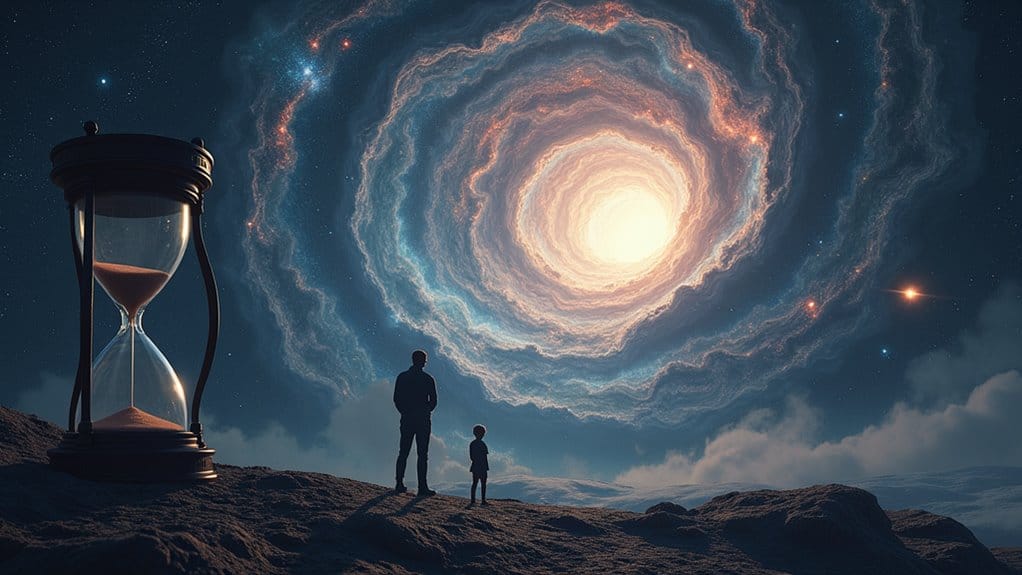
Narrative structures play an essential role in storytelling, shaping how audiences engage with the plot and characters. In Interstellar, the film employs innovative narrative techniques that enhance its emotional resonance and thematic depth.
By utilizing a non-linear plot structure, it invites viewers to piece together complex character arcs and appreciate storytelling evolution in science fiction.
- Nested loops create rich layers of meaning.
- Converging ideas enhance audience engagement.
- Classic arcs, like the Hero’s Journey, connect personal growth to cosmic exploration.
This narrative complexity not only keeps you on your toes but also deepens your understanding of the film’s core themes, making the experience both intellectually stimulating and emotionally impactful.
Ultimately, Interstellar exemplifies how narrative structures can elevate storytelling.
Hegel vs. Heidegger Debate

As you explore the contrasting philosophies of Hegel and Heidegger, consider how each thinker approaches the concept of place and human existence.
Hegel suggests that our understanding grows through the creation of distinctions and fictions, while Heidegger warns that losing our rootedness in place can lead to self-displacement, challenging our freedom.
Place and Human Existence
While exploring the philosophical themes in *Interstellar*, the debate between Hegel and Heidegger on place and human existence becomes essential.
Hegel views place as a limitation to human freedom, arguing that true emancipation comes from creating a fictional self that transcends its context.
On the other hand, Heidegger emphasizes the significance of being rooted in place, grounding human existence and authenticity.
Consider these key ideas:
- Place as Limitation: Hegel sees it as a barrier.
- Rootedness and Authenticity: Heidegger values being connected to your environment.
- Existential Grounding: Both philosophers provide insights on how place shapes identity.
Ultimately, their contrasting perspectives illuminate the profound implications of place significance in our lives, urging you to reflect on your own existential grounding.
Self-Displacement and Freedom
Understanding the tension between self-displacement and freedom requires recognizing how Hegel and Heidegger approach these concepts differently. Hegel critiques self-displacement as a necessary step towards true freedom, viewing estrangement from place as essential for self-consciousness and moral action. In contrast, Heidegger emphasizes rootedness, arguing that losing connection to our environment threatens our authentic existence.
| Hegel’s Perspective | Heidegger’s Perspective |
|---|---|
| Estrangement is necessary for freedom. | Loss of rootedness is problematic. |
| Freedom involves systematic thought. | Authenticity requires being-in-the-world. |
| Fiction allows for self-determination. | Place is fundamental to identity. |
This debate highlights the complexities of freedom exploration, urging you to reflect on how self-displacement shapes your own understanding of freedom.
Fiction’s Role in Reality
Fiction plays a pivotal role in shaping our perceptions of reality, presenting a stark contrast between Hegel’s and Heidegger’s philosophies.
For Hegel, fiction is crucial for creating existential distinctions, as it enables freedom from context and acts as a catalyst for revolutionary change. You might find it intriguing to reflect on:
- Fiction as a pathway to fictional autonomy, allowing you to envision new possibilities.
- The belief that fiction precedes truth, offering a foundation for knowledge.
- Hegel’s view that fiction is fundamental for guiding consciousness toward philosophy.
In contrast, Heidegger critiques this, emphasizing the meaningfulness of lived experience and the dangers of losing our rootedness in place.
His perspective invites you to rethink how fiction can bridge our understanding of being and reality.
Science and Philosophy Intertwined
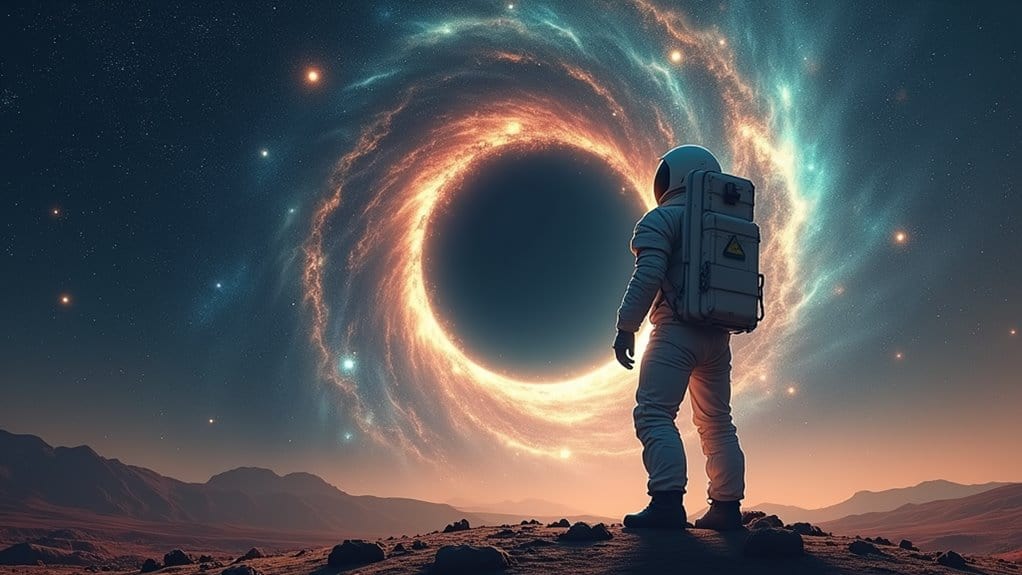
As you explore the film “Interstellar,” you’ll notice how seamlessly science and philosophy intertwine, creating a rich tapestry of thought-provoking themes. The film invites you to ponder quantum entanglement as it relates to love, showcasing its transcendence beyond mere scientific explanation. Additionally, it tackles moral relativism, questioning humanity’s ethical right to terraform new worlds.
| Scientific Concepts | Philosophical Themes |
|---|---|
| Wormholes | Human Existence |
| Gravitational Lensing | Ethical Considerations |
| Emotional Rationality | Dual Nature of Humanity |
Through these elements, “Interstellar” emphasizes the delicate balance between rational thought and emotional depth, prompting you to reflect on the complexities of human existence in the vast universe.
Conclusion
In exploring *Interstellar*, you uncover a tapestry of philosophical themes that challenge your understanding of existence, time, and love. The film’s ability to intertwine complex ideas with emotional depth is nothing short of a cosmic revelation, inviting you to reflect on your place in the universe. As you navigate its narrative, you’re reminded that the power of storytelling transcends mere entertainment; it becomes a portal to profound insights about humanity and our interconnectedness with the cosmos.



